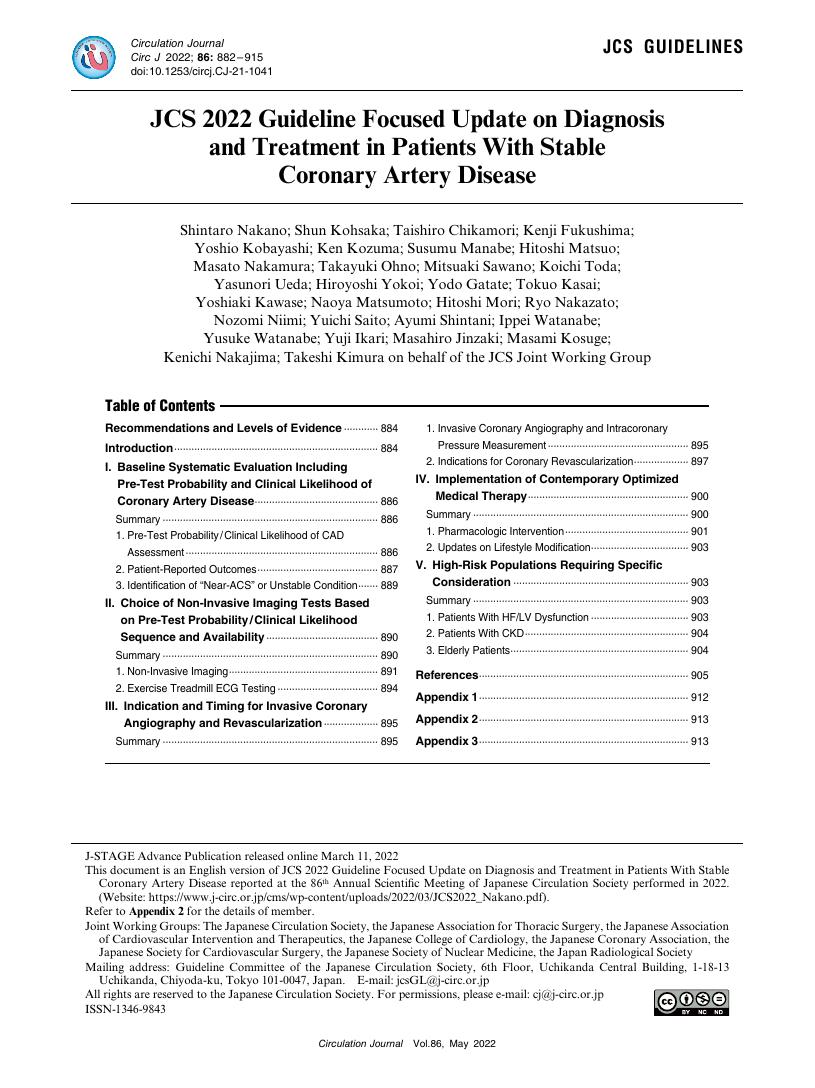11 0 0 0 OA JCS 2022 Guideline Focused Update on Diagnosis and Treatment in Patients With Stable Coronary Artery Disease
- 著者
- Shintaro Nakano Shun Kohsaka Taishiro Chikamori Kenji Fukushima Yoshio Kobayashi Ken Kozuma Susumu Manabe Hitoshi Matsuo Masato Nakamura Takayuki Ohno Mitsuaki Sawano Koichi Toda Yasunori Ueda Hiroyoshi Yokoi Yodo Gatate Tokuo Kasai Yoshiaki Kawase Naoya Matsumoto Hitoshi Mori Ryo Nakazato Nozomi Niimi Yuichi Saito Ayumi Shintani Ippei Watanabe Yusuke Watanabe Yuji Ikari Masahiro Jinzaki Masami Kosuge Kenichi Nakajima Takeshi Kimura on behalf of the JCS Joint Working Group
- 出版者
- The Japanese Circulation Society
- 雑誌
- Circulation Journal (ISSN:13469843)
- 巻号頁・発行日
- pp.CJ-21-1041, (Released:2022-03-11)
- 参考文献数
- 245
- 被引用文献数
- 40
- 著者
- Hiroyuki Omori Yoshiaki Kawase Takuya Mizukami Toru Tanigaki Tetsuo Hirata Munenori Okubo Hiroki Kamiya Akihiro Hirakawa Masanori Kawasaki Takeshi Kondo Takahiko Suzuki Hitoshi Matsuo
- 出版者
- The Japanese Circulation Society
- 雑誌
- Circulation Journal (ISSN:13469843)
- 巻号頁・発行日
- pp.CJ-22-0771, (Released:2023-03-28)
- 参考文献数
- 22
- 被引用文献数
- 2
Background: Angiographic fractional flow reserve (angioFFR) is a novel artificial intelligence (AI)-based angiography-derived fractional flow reserve (FFR) application. We investigated the diagnostic accuracy of angioFFR to detect hemodynamically relevant coronary artery disease.Methods and Results: Consecutive patients with 30–90% angiographic stenoses and invasive FFR measurements were included in this prospective, single-center study conducted between November 2018 and February 2020. Diagnostic accuracy was assessed using invasive FFR as the reference standard. In patients undergoing percutaneous coronary intervention, gradients of invasive FFR and angioFFR in the pre-senting segments were compared. We assessed 253 vessels (200 patients). The accuracy of angioFFR was 87.7% (95% confidence interval [CI] 83.1–91.5%), with a sensitivity of 76.8% (95% CI 67.1–84.9%), specificity of 94.3% (95% CI 89.5–97.4%), and area under the curve of 0.90 (95% CI 0.86–0.93%). AngioFFR was well correlated with invasive FFR (r=0.76; 95% CI 0.71–0.81; P<0.001). The agreement was 0.003 (limits of agreement: −0.13, 0.14). The FFR gradients of angioFFR and invasive FFR were comparable (n=51; mean [±SD] 0.22±0.10 vs. 0.22±0.11, respectively; P=0.87).Conclusions: AI-based angioFFR showed good diagnostic accuracy for detecting hemodynamically relevant stenosis using invasive FFR as the reference standard. The gradients of invasive FFR and angioFFR in the pre-stenting segments were comparable.
- 著者
- Hiroyuki Omori Hideaki Ota Takuya Mizukami Yoshiaki Kawase Toru Tanigaki Tetsuo Hirata Munenori Okubo Masanori Kawasaki Hitoshi Matsuo
- 出版者
- The Japanese Circulation Society
- 雑誌
- Circulation Journal (ISSN:13469843)
- 巻号頁・発行日
- vol.85, no.8, pp.1404, 2021-07-21 (Released:2021-07-21)
- 参考文献数
- 2
- 被引用文献数
- 3
- 著者
- Shintaro Nakano Shun Kohsaka Taishiro Chikamori Kenji Fukushima Yoshio Kobayashi Ken Kozuma Susumu Manabe Hitoshi Matsuo Masato Nakamura Takayuki Ohno Mitsuaki Sawano Koichi Toda Yasunori Ueda Hiroyoshi Yokoi Yodo Gatate Tokuo Kasai Yoshiaki Kawase Naoya Matsumoto Hitoshi Mori Ryo Nakazato Nozomi Niimi Yuichi Saito Ayumi Shintani Ippei Watanabe Yusuke Watanabe Yuji Ikari Masahiro Jinzaki Masami Kosuge Kenichi Nakajima Takeshi Kimura on behalf of the JCS Joint Working Group
- 出版者
- The Japanese Circulation Society
- 雑誌
- Circulation Journal (ISSN:13469843)
- 巻号頁・発行日
- vol.86, no.5, pp.882-915, 2022-04-25 (Released:2022-04-25)
- 参考文献数
- 245
- 被引用文献数
- 40
- 著者
- Hitoshi Matsuo Tomohiro Kawasaki Tetsuya Amano Yoshiaki Kawase Yoshihiro Sobue Takeshi Kondo Yoshihiro Morino Shunichi Yoda Tomohiro Sakamoto Hiroshi Ito Junya Shite Hiromasa Otake Nobuhiro Tanaka Mitsuyasu Terashima Kazushige Kadota Manesh R. Patel Koen Nieman Campbell Rogers Bjarne L. Norgaard Jeroen J. Bax Kavitha M. Chinnaiyan Daniel S. Berman Timothy A. Fairbairn Lynne M. Hurwitz Koweek Jonathon Leipsic Takashi Akasaka
- 出版者
- The Japanese Circulation Society
- 雑誌
- Circulation Reports (ISSN:24340790)
- 巻号頁・発行日
- vol.2, no.7, pp.364-371, 2020-07-10 (Released:2020-07-10)
- 参考文献数
- 9
- 被引用文献数
- 1
Background:Coronary computed tomography angiography (CCTA)-derived fractional flow reserve (FFRCT) is an established tool for identifying lesion-specific ischemia that is now approved for use by the Japanese insurance system. However, current clinical reimbursement is strictly limited to institutions with designated appropriate use criteria (AUC). This study assessed differences in physicians’ behavior (e.g., use and interpretation of FFRCT, final management) according to Japanese AUC and non-AUC site designation.Methods and Results:Of 5,083 patients in the ADVANCE Registry, 1,829 from Japan were enrolled in this study. Physicians’ behavior after interrogating CCTA and FFRCTwas analyzed separately according to AUC and non-AUC site designation. Compared with AUC sites, patients referred for FFRCTfrom non-AUC sites had a higher rate of negative FFRCT, less severe anatomic stenosis, and a slightly lower rate of management plan reclassification (51.2% vs. 61.3%), with near-identical utility in both groups. Actual care corresponded equally well to post-FFRCTplans in both groups. The likelihood of revascularization for positive or negative FFRCTwas similar between the 2 groups. Importantly, AUC and non-AUC sites were equally unlikely to revascularize patients with negative FFRCTand stenosis >50% or patients with positive FFRCTand stenosis <50%.Conclusions:Compared with AUC sites, non-AUC sites had lower disease burden and reclassification of management plans, but nearly identical clinical integration. Actual care corresponded equally well to post-FFRCTrecommendations at both sites.
